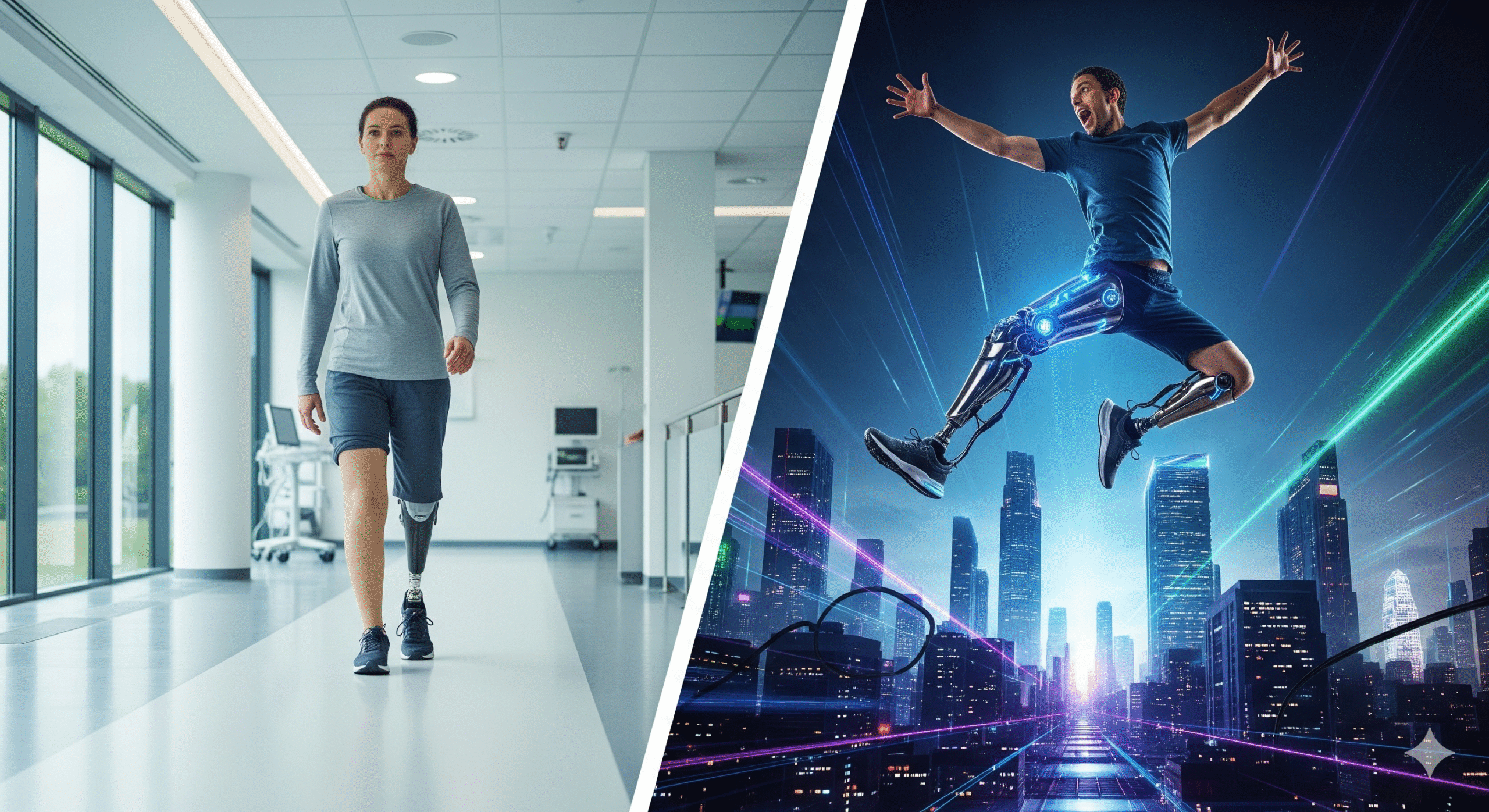The concept of human enhancement is as old as civilization itself. For thousands of years, humans have used tools, techniques, and technologies to go beyond their natural limits. We invented eyeglasses to correct vision, used vaccines to strengthen our immune systems, and developed prosthetics to replace lost limbs. These were, in a sense, the first forms of enhancement, aimed at restoring a person to a normal, healthy state.
However, the modern era of human enhancement is marked by a significant shift. We are moving from mere restoration to outright augmentation. The lines are blurring between therapy (correcting a deficit) and enhancement (improving upon normal human function).
- Therapeutic Technologies: These are designed to treat diseases or disabilities and restore a person to a “normal” level of functioning. Examples include:
- Antibiotics to cure an infection.
- A heart transplant for a failing organ.
- A cochlear implant to restore hearing in a deaf person.
- Enhancement Technologies: These are designed to improve human capacities beyond the average or healthy state. Examples include:
- A “smart drug” that boosts a healthy person’s memory beyond the norm.
- Genetic engineering to give a child a higher-than-average IQ or athletic ability.
- A brain-computer interface that allows a person to control technology with their thoughts, a function no human has naturally.
This distinction is the core of the ethical debate. While most people agree that using a prosthetic to help an amputee walk is a moral good, the consensus breaks down when we talk about a prosthetic that allows an athlete to run faster than any human has ever run before.
A Tale of Two Futures: Therapy vs. Enhancement
The ethical debate around human enhancement is often framed by a clear distinction between therapeutic and enhancement uses. While the distinction can sometimes be blurry, it provides a crucial framework for understanding the core arguments.
| Attribute | Therapeutic Enhancement | Pure Enhancement |
| Primary Goal | Correction. To treat a disease, disability, or a specific deficit to restore “normal” function. | Improvement. To go beyond “normal” human capacities, creating a new, superior level of function. |
| Ethical Consensus | Broadly Accepted. Seen as a moral good, as it alleviates suffering and restores health. | Highly Debated. Raises serious ethical questions about fairness, safety, and human identity. |
| Examples | A prosthetic leg for an amputee, a vaccine, a cochlear implant for a deaf person. | A prosthetic that allows a person to run at superhuman speeds, a drug that improves a healthy person’s memory, genetic engineering for increased intelligence. |
| Social Impact | Neutral to Positive. It reduces suffering and can lead to a more inclusive society. | Potentially Negative. Could create a social and economic divide, leading to a “super-class” of enhanced individuals. |
| Medical Justification | Clear. The procedure is based on a diagnosis of a disease or a disability. | Lacking. The procedure is not medically necessary and is based on a desire for improvement. |
Export to Sheets
This comparison shows that while therapeutic technologies are largely seen as ethical, enhancement technologies are where the ethical waters become murky. The line between these two concepts is the very heart of the public debate.
The Promise: The Unseen Benefits of Human Enhancement
The ethical debate wouldn’t be so complex if the potential benefits of human enhancement weren’t so profound. Proponents of these technologies argue that they are not just about creating a “perfect” human, but about alleviating suffering and unlocking our full potential.
1. The End of Disease and Disability
Imagine a world without genetic diseases. Gene-editing technologies like CRISPR offer the promise of correcting genetic flaws before a child is even born, potentially eradicating conditions like cystic fibrosis, Huntington’s disease, and sickle cell anemia. Similarly, advanced prosthetics and neural interfaces could allow people with disabilities to not only regain function but to experience the world in new and powerful ways. This is the most compelling argument for human enhancement—the ability to cure and prevent human suffering on a scale never before imagined.
2. A New Era of Cognitive and Physical Prowess
Beyond curing disease, human enhancement technologies could unlock new levels of human performance. Brain-computer interfaces could allow a person to learn a new language in hours, not years. Gene therapy could enable athletes to train harder and recover faster, pushing the limits of human endurance. These technologies could usher in a new era of intellectual and physical achievement, allowing humanity to tackle grand challenges and explore new frontiers.
3. A Holistic Improvement in Quality of Life
For many, enhancement technologies could simply lead to a better quality of life. The potential to extend the human lifespan could give us more time with our loved ones, more time to pursue our passions, and more time to contribute to society. Similarly, aesthetic enhancements could boost a person’s self-esteem and happiness.
The Perils: The Ethical Minefield of Human Enhancement
Despite the immense promise, the ethical concerns surrounding human enhancement are a very real and serious obstacle that must be addressed.
1. The Equity Gap: A New Social Divide
This is perhaps the most serious ethical concern. If human enhancement technologies are expensive and only available to the wealthy, we could see the creation of a new, biologically superior upper class. A world where the rich are not only richer but are also smarter, healthier, and live longer could lead to a social divide that is far more rigid and unchangeable than anything we have ever seen. This could create a biological caste system, leading to a new form of inequality that is almost impossible to overcome.
2. Safety and Unforeseen Consequences
We are playing with the fundamental building blocks of human life. The long-term effects of genetic engineering, brain-computer interfaces, and other radical enhancements are largely unknown. There is a risk of unintended consequences that could have devastating effects on an individual and even on the human species as a whole. A single misstep could lead to a new disease or an unforeseen change in human behavior.
3. The Definition of “Human”
The more we enhance ourselves, the more we blur the line between human and machine. If we replace parts of our body with bionic components or merge our consciousness with a computer, at what point do we cease to be human? This is a fundamental philosophical question that we will have to answer. Is our humanity tied to our biology, our consciousness, or our ability to feel? Human enhancement forces us to confront this question head-on.
4. Social Coercion and the “Rat Race”
In a society where human enhancement is common, there could be immense social pressure to undergo these procedures just to keep up. An athlete might feel coerced to use gene therapy to stay competitive, a student might feel compelled to take a “smart drug” to get into a good university, and an employee might feel pressured to enhance their memory to avoid being replaced. This could create a never-ending “rat race” where people are constantly chasing the next enhancement, with no clear end in sight.
Use Cases: From the Lab to the Battlefield
The applications of human enhancement are as diverse as the people who might use them. While much of the debate focuses on a distant, futuristic world, these technologies are already being developed for real-world use cases.
- The Military: The military is a major driver of human enhancement research. The goal is to create “super-soldiers” who can endure more, react faster, and fight smarter. This could lead to soldiers with enhanced vision, strength, or cognitive function.
- Athletes: The world of sports is constantly seeking a competitive edge. Genetic engineering and other enhancement technologies could be used to give athletes an advantage, raising serious questions about the fairness and integrity of sports.
- The Average Person: A significant portion of the population might seek enhancements to improve their quality of life. This could range from a parent taking a drug to stay more focused to a person undergoing a procedure to improve their memory.
- Patients: A person with a severe disability might use a brain-computer interface to communicate, an application that is seen as therapeutic, but could pave the way for more enhanced uses.
FAQs: Your Questions on Human Enhancement Answered
What are the types of human enhancement?
Human enhancement can be broadly categorized into three types:
- Mechanical/Prosthetic: Such as bionic limbs and exoskeletons.
- Pharmacological: Such as “smart drugs” or performance-enhancing drugs.
- Genetic/Biological: Such as gene editing and stem cell therapy.
Is gene editing a form of human enhancement?
Yes, it can be. Gene editing is a form of human enhancement when it is used to go beyond the correction of a genetic disorder and is instead used to enhance a trait like intelligence, height, or strength.
What are the biggest ethical concerns of human enhancement?
The biggest ethical concerns include the creation of a social and economic divide, the unknown long-term safety risks, the loss of human identity, and the potential for social coercion to use these technologies.
Where is the line between therapy and enhancement?
The line is often drawn between correcting a medical condition (therapy) and improving on a healthy state (enhancement). For example, a prosthetic that allows an amputee to walk is therapy. A prosthetic that allows a person to run faster than a human could naturally is enhancement.
What is transhumanism?
Transhumanism is a philosophical and intellectual movement that advocates for the use of science and technology to overcome human limitations. Transhumanists believe that human enhancement is not just an option but a moral imperative.
Conclusion: The Choice Is Ours
The era of human enhancement is no longer a distant possibility; it is a present reality. The technology is advancing at a breathtaking pace, and with it, the ethical questions are becoming more urgent. We are on the precipice of a new stage of human evolution—one that we, for the first time, have the power to direct.







Leave a Reply